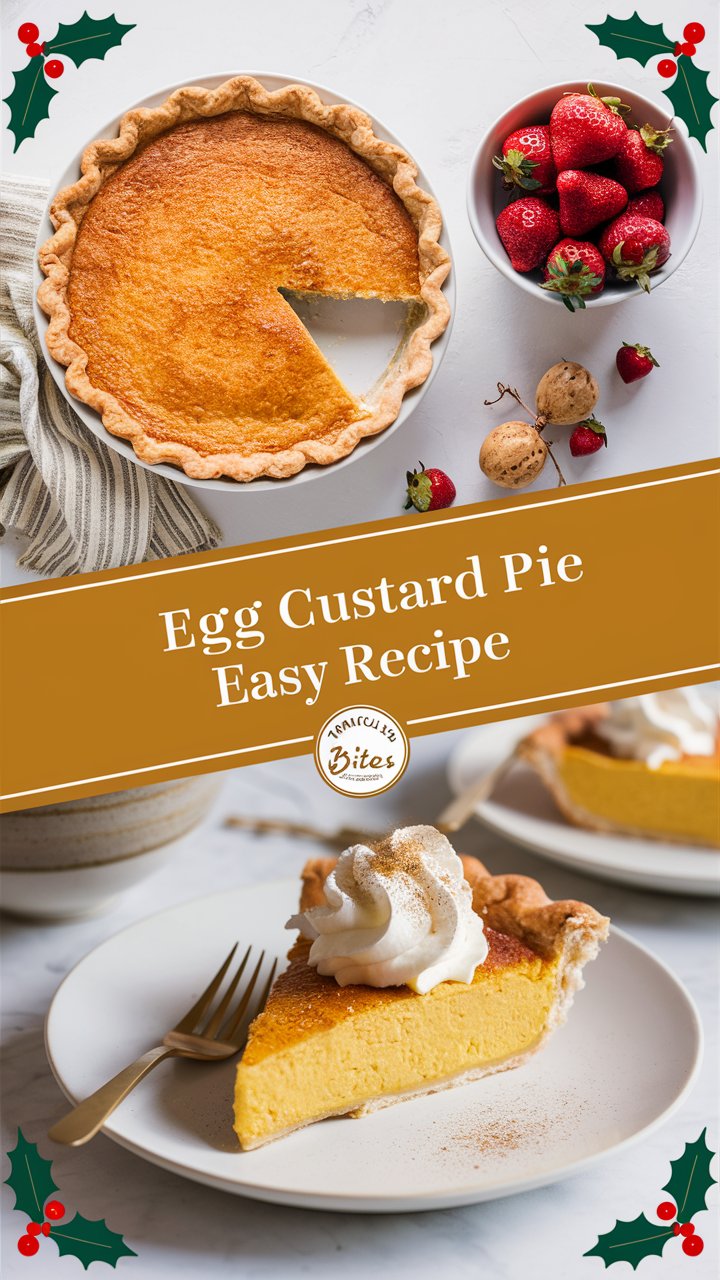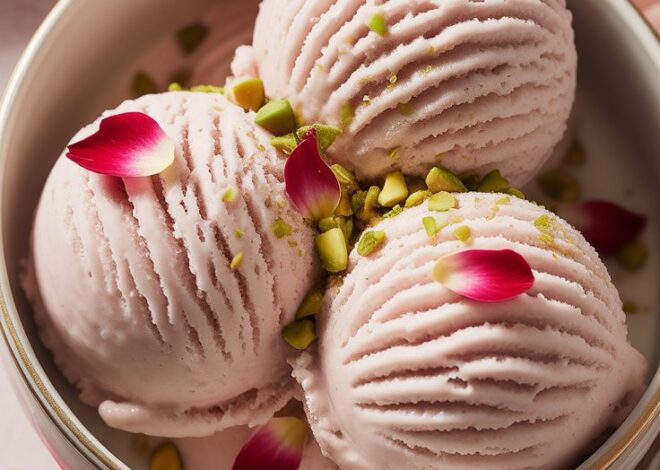
How to Make the Perfect Creamy Egg Custard Pie at Home 2025
When it comes to comfort food desserts, few recipes evoke the same warm, nostalgic feelings as a perfectly baked Egg Custard Pie. This classic dessert, with its silky, creamy filling and golden, flaky crust, has been a beloved favorite across generations. Whether served at family gatherings, holidays, or a simple afternoon treat, this pie delivers both simplicity and indulgence in every bite.
In this article, we will explore everything you need to know about making a Creamy and Easy Egg Custard Pie — from selecting ingredients and mastering the technique to troubleshooting common pitfalls and adding delightful variations. Designed to be approachable for novice bakers and satisfying for seasoned chefs, this recipe and guide will elevate your baking game while preserving the heartwarming essence of this classic dessert.
What Makes Egg Custard Pie So Special?
Egg custard pie is a testament to the beauty of simplicity in baking. Unlike complex cakes or frosted pastries, this pie relies on a handful of basic pantry staples — eggs, milk, sugar, and vanilla — combined thoughtfully to create a smooth custard that’s both delicate and rich. The key lies in the balance: the custard must be creamy yet firm enough to slice neatly, with a golden, slightly nutty crust that provides the perfect contrast in texture.
Its appeal is also tied to its versatility. Served warm or chilled, topped with a sprinkle of nutmeg or a dollop of whipped cream, egg custard pie suits any occasion. It’s a dessert that speaks to the soul, offering comfort and a taste of home with every forkful.
History and Origins of Egg Custard Pie
Understanding the origins of egg custard pie adds an enriching layer to your baking experience. Custards have been a part of culinary traditions around the world for centuries, originating from ancient recipes in Europe and Asia that utilized eggs and milk to create smooth, sweetened puddings.
The pie form, combining custard filling with a pastry crust, became particularly popular in British and American households by the 18th and 19th centuries. It was cherished for its straightforward ingredients and satisfying flavor, becoming a staple in Southern American cuisine and British teatime menus alike.
Ingredients Breakdown: Why Each One Matters
1. Eggs
Eggs are the backbone of custard. Their proteins coagulate during baking, thickening the mixture into a creamy yet sliceable texture. Using fresh, large eggs ensures optimal structure and richness.
2. Milk
Whole milk is preferred for its creamy mouthfeel and natural sweetness. Scalding the milk before mixing helps dissolve the sugar better and creates a smoother custard by partially denaturing milk proteins.
3. Sugar
Granulated sugar sweetens the custard and helps create a tender texture. The quantity can be adjusted to taste, but the balance is critical to avoid an overly sweet or bland pie.
4. Nutmeg
Nutmeg adds a warm, fragrant note traditionally associated with custard desserts. It complements the vanilla and enriches the overall flavor profile.
5. Vanilla Extract
Vanilla provides depth and aromatic complexity. Pure vanilla extract is best, though vanilla bean paste can be used for a more intense flavor.
6. Pie Crust
A flaky, buttery pie crust acts as the foundation, holding the custard while adding texture contrast. You can use store-bought crusts for convenience or homemade for a personalized touch.
Step-by-Step Guide to Making Creamy and Easy Egg Custard Pie
Step 1: Preparing Your Pie Crust
- Preheat your oven to 350°F (175°C).
- If using a store-bought crust, let it thaw to room temperature.
- Gently place the crust into a 9-inch pie dish, pressing evenly.
- Crimp the edges decoratively to seal.
- For a crisper bottom, consider blind baking the crust for 8-10 minutes; however, many prefer baking the custard directly in an unbaked crust for better texture balance.
Step 2: Scalding the Milk
- Pour 2½ cups of whole milk into a saucepan.
- Heat over medium heat until small bubbles form around the edges and steam rises, but do not let it boil.
- Remove from heat and allow the milk to cool slightly — this prevents cooking the eggs prematurely.
Step 3: Mixing the Custard Base
- In a mixing bowl, whisk together 3 large eggs, ¾ cup granulated sugar, ¼ teaspoon salt, and ¼ teaspoon ground nutmeg until smooth.
- Slowly add the warm milk in a thin stream while whisking constantly to blend and prevent curdling.
- Stir in 1 teaspoon of vanilla extract for flavor.
Step 4: Assembling and Baking
- Pour the custard mixture into the prepared pie crust.
- Lightly sprinkle additional nutmeg on top for aroma and a beautiful golden finish.
- Bake for 45 to 50 minutes. The custard should be set around the edges but slightly jiggly in the center.
- To test doneness, insert a knife near the center; it should come out clean.
Step 5: Cooling and Serving
- Allow the pie to cool completely on a wire rack.
- For the best texture, refrigerate for at least 2 hours before slicing.
- Serve chilled or at room temperature.
- Optional toppings: whipped cream, fresh berries, or a caramel drizzle.
Tips for Perfect Custard Every Time
- Use fresh ingredients: Fresh eggs and good-quality milk are essential for taste and texture.
- Avoid overbaking: Overcooked custard will become grainy and crack. Monitor closely in the last 10 minutes.
- Whisk continuously: When mixing eggs and milk, constant whisking prevents scrambling.
- Use a water bath (optional): Baking your pie in a water bath adds moisture to the oven, reducing cracking and ensuring even cooking.
- Chill well: Custard needs time to set firmly, so don’t rush the cooling process.
Common Mistakes and How to Avoid Them
- Watery or runny custard: Usually caused by underbaking or not allowing the pie to cool properly.
- Cracked surface: Typically from overbaking or rapid temperature changes.
- Soggy crust: Blind baking the crust or using a crust shield can help prevent a soggy bottom.
- Scrambled eggs in custard: Adding cold milk to eggs or not whisking properly causes curdling.
Nutritional Information (Approximate per slice)
- Calories: 250-300
- Protein: 6g
- Fat: 10g
- Carbohydrates: 35g
- Sugar: 25g
This pie is a treat to be enjoyed in moderation but provides a comforting balance of carbs and protein.
Variations to Customize Your Egg Custard Pie
- Rich Cream Custard: Replace ½ cup milk with heavy cream for extra creaminess.
- Spiced Custard: Add cinnamon, cardamom, or allspice alongside nutmeg.
- Coconut Custard: Substitute part of the milk with coconut milk for a tropical twist.
- Sugar-Free Version: Use natural sweeteners like stevia or erythritol and adjust baking times.
- Crust Alternatives: Use graham cracker crust or gluten-free crusts for dietary preferences.
Serving Suggestions and Pairings
- Pair with a hot cup of tea or coffee for a cozy afternoon snack.
- Top with fresh fruit such as sliced strawberries, blueberries, or peach slices.
- Add a dollop of lightly sweetened whipped cream or a drizzle of homemade caramel sauce.
- Serve alongside a scoop of vanilla bean ice cream for a delightful contrast of temperatures.
Frequently Asked Questions (Expanded)
What is the purpose of scalding milk in custard?
Scalding milk alters the protein structure, helping sugar dissolve better and preventing curdling when mixed with eggs. It also contributes to a smoother custard texture.
Can I use low-fat or plant-based milk?
Yes, but expect a thinner custard and slightly different flavor. Whole milk or cream yield the best richness.
How do I store leftover custard pie?
Cover tightly with plastic wrap and refrigerate. Consume within 3-4 days for optimal freshness.
Why does my custard pie crack?
Usually from overbaking or sudden cooling. Baking in a water bath and cooling gradually can prevent cracks.
The Science Behind Custard Perfection
Custard is a delicate balance of proteins, fats, and sugars. When heated, egg proteins coagulate and thicken the mixture without turning rubbery if carefully controlled. The sugar softens the proteins, while milk fat adds richness and tenderness. Understanding this helps bakers control texture and avoid common pitfalls.
Final Thoughts
Making a Creamy and Easy Egg Custard Pie is more than following a recipe—it’s about embracing a classic tradition with precision, patience, and a little love. With minimal ingredients and straightforward steps, this dessert welcomes beginners while satisfying even the most discerning palates.
By paying attention to ingredient quality, technique, and baking cues, anyone can master this timeless favorite. Whether enjoyed plain or garnished with your favorite toppings, the warm nostalgia and comforting taste of egg custard pie will keep you coming back for more.
Ready to Bake?
Gather your ingredients and treat yourself to this heartwarming dessert today. It’s simple, elegant, and truly delicious — a perfect ending to any meal or a sweet pick-me-up anytime.


